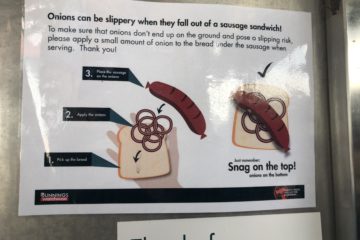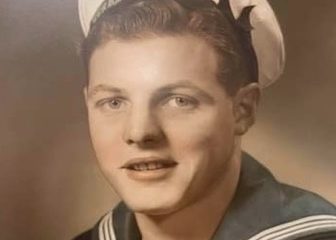Japanese sword welcomed into national collection
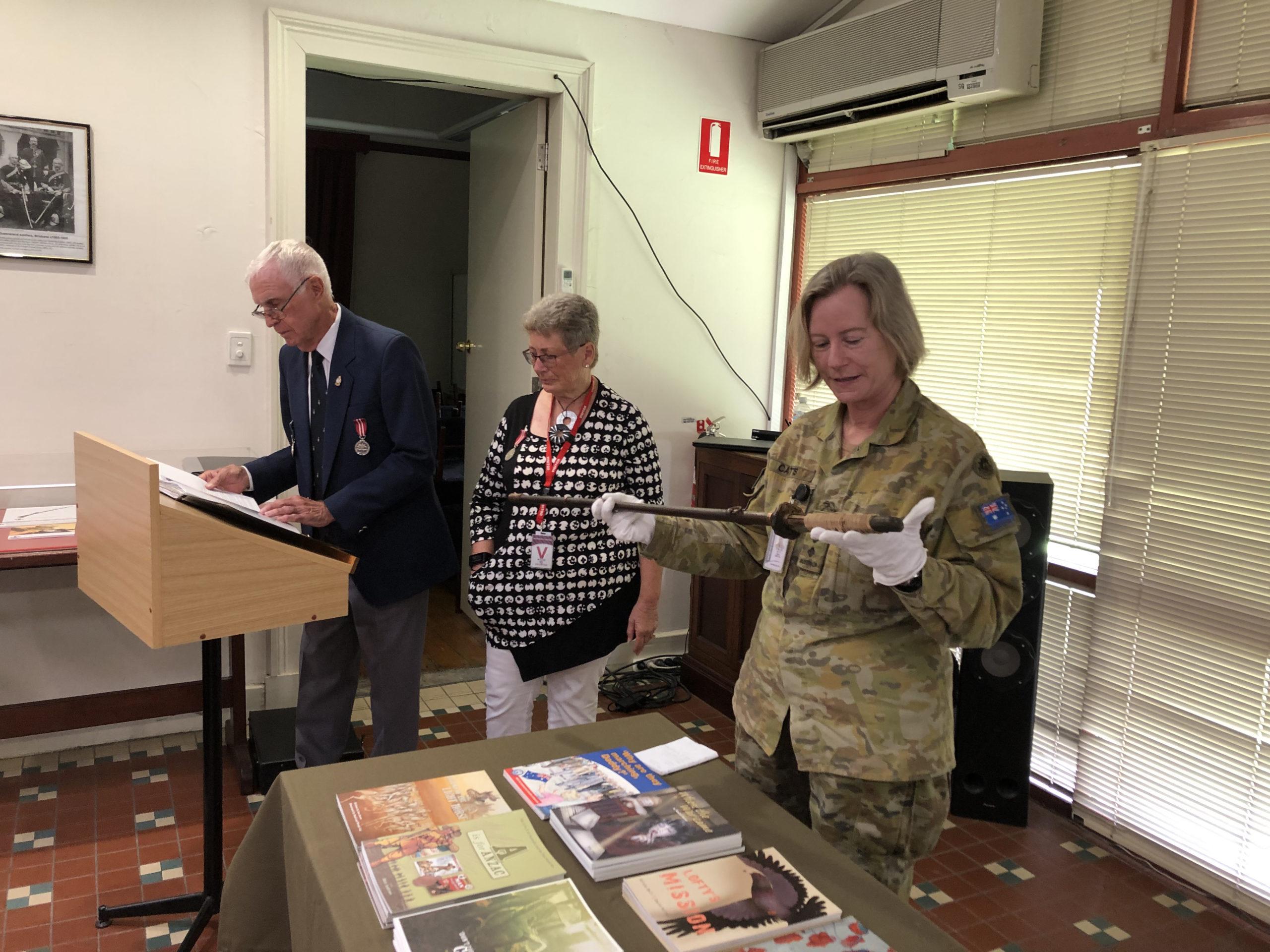
ABOVE: Curator of the Army Museum South Queensland, CAP Adele Catts, admires the sword of an Imperial Japanese Army soldier. The extraordinary object was part of the legacy collection donated by the family of the late PTE Allan Yates Hynes, formerly of Australia’s 55th/53rd Infantry Battalion during World War II, and the late Alan Edmund Powell of Sydney. In the background is Brian Powell and Phyllis Powell (neé Hynes). Photo courtesy of Peter Collins.
SANDGATE Sub-Section was proud to be associated with the addition of hundreds of Great War and World War II-related military insignia, badges, books and ephemera into the collection of the Army Museum South Queensland at Brisbane’s Victoria Barracks today.
The incredible gift represented the lion’s share of a private collection gathered from around the world by former high school teacher, the late Alan Edmund Powell of Sydney.
To the cache was added a Japanese Imperial Army sword souvenired from the battlefields of the South-Western Pacific Theatre by the late PTE Allan Yates Hynes (NX155605/N175398). The object, which is in an astonishing state of preservation, was inherited by Mr Hynes’s children, Mrs Phyllis Joyce Powell (neé Hynes) and Mr Leslie George Hynes.
Retirees, Brian and Phyllis Powell of Brisbane, were the special guests at a handover ceremony in the historic Officers’ Mess – in the presence of Terry McLeod, Treasurer CDR Darryl Neild OAM (RAN, Retd.), President Darby Ashton, and Social Media Curator Peter Collins of the Naval Association of Australia (Sandgate Sub-Section), as well as invited guests – on Wednesday morning, 6 April 2022.
Mr Powell told the audience the sword was acquired by his late father-in-law, PTE Hynes, at Rabaul, New Guinea, in 1946.
“PTE Hynes had enlisted in the Militia in October 1941 at the age of 21 and was initially posted to 35th Infantry Battalion at Wallgrove, NSW,” he said.
“Two months later he was transferred to 53rd Infantry Battalion at Ingleburn. The Battalion sailed from Sydney on the Aquitania on 21 December 1941 for Port Moresby, arriving there in January 1942, but without PTE Hynes. He briefly had been in hospital, but rejoined his unit later.
“The Battalion was involved in labouring and garrison duties there for six months – while subject to air raids and various diseases – with minimal training and lacking numbers and experience at all levels.
“Because of the nature of their duties, Tokyo Rose described the Battalion’s members as the ‘Mice of Moresby.’
“The Battalion was involved in combat with the Japanese at various locations on the Kokoda Track, from late July to October 1942, before being returned to Port Moresby where it was re-amalgamated with 55th Infantry Battalion.
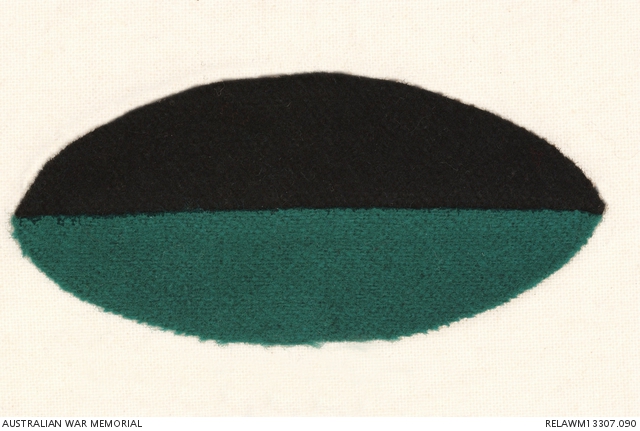
ABOVE: The Unit Badge of the 2nd AIF’s 33rd Battalion. Image courtesy of the Australian War Memorial. Item No. 3830025.
“The 55th/53rd Battalion was flown to fight the Japanese at Sanananda and Gona during December 1942 and January 1943, before again being returned to Port Moresby.
“The amalgamated Battalion returned to Australia in March 1943 and some or all of the components were located at a number of locations in the Cairns and Townsville areas, Thursday Island, Canungra and Strathpine until the end of 1944, where they were trained, did a variety of duties, recovered from illnesses, had recreation activities and went on leave.
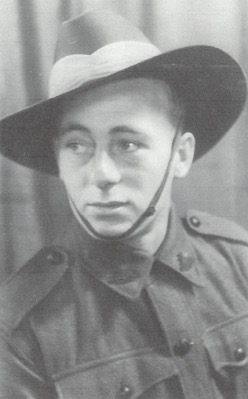
ABOVE: Former 2nd AIF soldier, PTE Allan Hynes, photographed shortly after he enlisted in 1941.
“During this period PTE Hynes underwent long periods of hospitalisation, recovering from malaria and other medical conditions.
“The Battalion sailed from Brisbane on USS Sea Snipe in December 1944 for Torokina, Bougainville, with new equipment and wearing jungle greens for the first time. There the Battalion was mainly involved in patrols and skirmishes with the Japanese.
“The Battalion’s status was changed from a Militia Battalion to an AIF Battalion on 13 April 1945.
“After peace was declared on 10 August 1945, the Battalion sailed on Kanimbla to Rabaul, New Britain, in September 1945 for ‘mopping up’ activities.
“In his book, That Mob – The Story of the 55th, 53rd Australian Infantry Battalion, A.I.F., Frank M. Budden, states that: ‘An issue of Japanese swords was made, but due to limited numbers, they were issued one to every group of men of a specific number; then came the lottery to see who would be the eventual owners.’
“Presumably this is how PTE Hynes acquired the sword, which he brought to Sydney – in January 1946, again on the Kanimbla – where he was discharged in May 1946.
“He died in Sydney in 1973 at the young age of 52 as a result of the ongoing effects of malaria and other diseases acquired in New Guinea.
“The sword is presented to Army Museum South Queensland, Victoria Barracks, Brisbane, in April 2022, by his daughter, Phyllis Joyce Powell, and son, Leslie George Hynes (a legatee) in accordance with the wishes of Allan’s late widow, Nita Joyce Hynes.
“His campaign medals will be presented to the Museum at a later date.“
On behalf of the Army Museum South Queensland, curator, CAP Adele Catts, warmly thanked the Hynes and Powell Families for their extraordinary gift to the National Collection.
“It is a beautiful piece and a lovely story – and to actually have what we call ‘the provenance’ of the item is what is the really important thing,” CAP Catts said.
“It is exciting to know that this is a sword representing that particular gentleman’s service.”
Army Museum South Queensland also was gifted a cache of hundreds of books and military ephemera collected by Mr Powell’s older brother, the late Alan Edmund Powell, of Sydney.
“My elder brother passed away in June 2021 after a lifetime of collecting information and items relating to his wide range of interests,” Brian Powell explained.
“While at Hurstville Public School we collected the typical items of the time – stamps and cigarette packet cards, matchbox labels, lapel badges and the variety of cards which were included in breakfast cereal boxes.
“In our high school years we collected interesting information on the armed services and all modes of transport.”
CAP Catts said that buttons, shoulder colour patches, cap badge and book collection was yet to be fully accessioned but described it as “wonderful.”
“It is an amazing collection from someone who clearly spent years and years and years of collecting and it is lovely that the entire collection has come into one place, rather than being split up,” she said.
“So I really do thank you both very much, Brian and Phyllis.”
Mr Powell revealed that his brother attended Sydney Boys’ High School, where he joined the school’s army cadet unit, rose to the rank of Cadet Warrant Officer Grade 2 and represented his school in rifle shooting.
“When finishing high school he applied for entry to Duntroon Military College but was not accepted,” he added.
“Instead, he attended the University of New South Wales to study for a science degree and joined that university’s Citizen Military Force Regiment.
“He remained in the University of New South Wales Regiment during his early years as a high school science teacher and headteacher, was commissioned as a Lieutenant in 1968 and resigned from the CMF in 1975.
“Alan’s involvement in the school cadets and CMF stimulated a particular interest in military history which resulted in an extensive collection of books and magazines (mainly obtained from opportunity shops and charity book sales) supplemented by original research covering:
- World Wars I and II and other recent conflicts;
- the structure, operations, weapons and uniforms of units of the Australian and British armies:
- the ships and operations of the Royal Australian Navy and Royal Navy (particularly their Fleet Air Arms);
- the structure, aircraft and operations of the Royal Australian Air Force, Royal Air Force and United States Air Force and Marines; and
- the history of other aspects of warfare.
“While Alan’s reading and research was mainly for his own interest and did not lead to publication, he contributed to research for Battlefield History Tours – tours he participated in to battlefields in Greece, Crete, France and Belgium and former RAF bases in England. Battlefield History Tours is operated by COL Graham Fleeton, who supported and encouraged Alan in his personal life and his military history interests throughout his adult life.”

ABOVE: The NSW University of Technology Regiment (now the University of New South Wales Regiment) guard of honour at the University’s first graduation ceremony on Kensington campus and opening of the Main Building on 16 April 1955, being inspected by the NSW Governor, Sir John Northcott. He is accompanied by CAP Brookes Wilson, the commander of the guard. Photo from the State Library of New South Wales Collection.
Mr Powell said his brother and COL Fleeton both belonged to the University of New South Wales Regiment Association.
“One of Alan’s special areas of interest in recent years was the structure and operations of units of the British Army in India during the 1940s and when India, Pakistan and Bangladesh gained independence,” he said.
“In addition to books and research material, Alan assembled a collection of regimental and Corps badges, shoulder flashes, colour patches and other insignia of the Australian and British armies.”
The Winston Hills (Sydney) science teacher’s eclectic and extensive collection of books, magazines and research also covered science (physics, chemistry, geology, zoology, botany, biology and astronomy), transport (aviation, railways, trams, buses and ferries), languages (particularly German, French and Latin), world history, geography, travel and other subjects to a lesser extent.
It was a “labour of love” that eventually saw some of the Royal Australian Navy and Royal Australian Air Force-related components within the 40-plus box tranche of volumes, papers and clippings compilations separated out by Sandgate Sub-Section volunteers and donated separately to the Pine Rivers and Sandgate Branch of the Queensland Division of the Royal Australian Air Force Association, and allocated to the inaugural library of Australian Navy Cadet’s Training Ship Paluma at Shorncliffe.
“Alan’s wish was that the books and items in his collection would be of continuing use to other interested individuals or organisations,” Mr Powell added.
